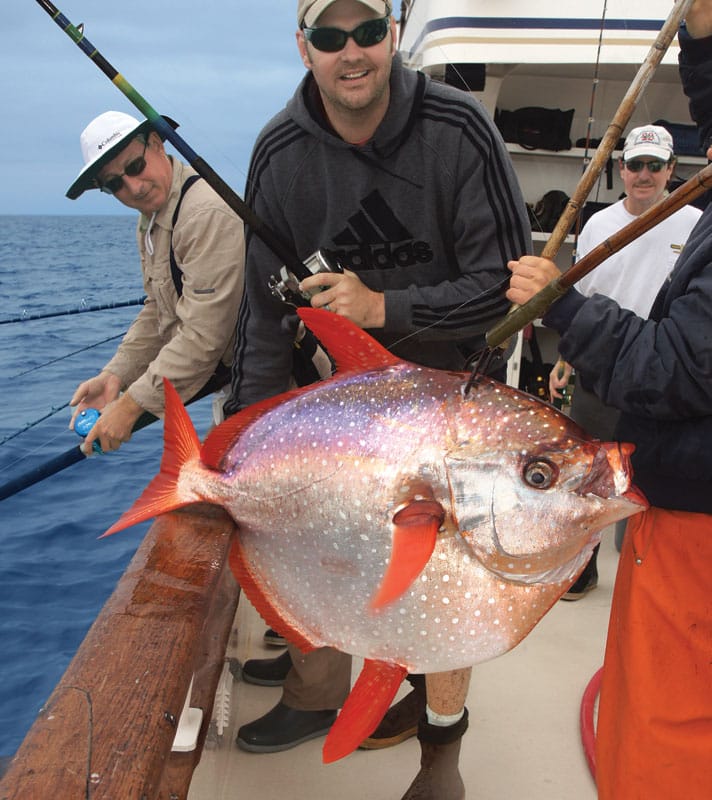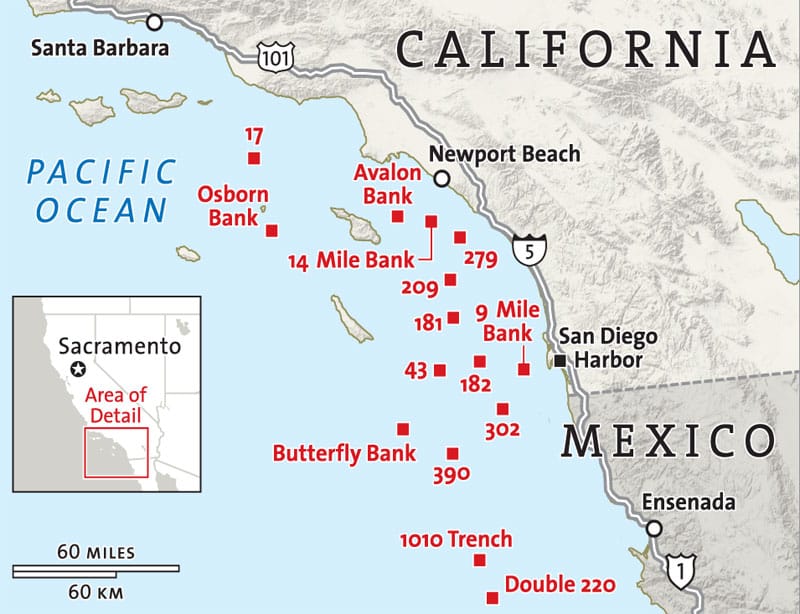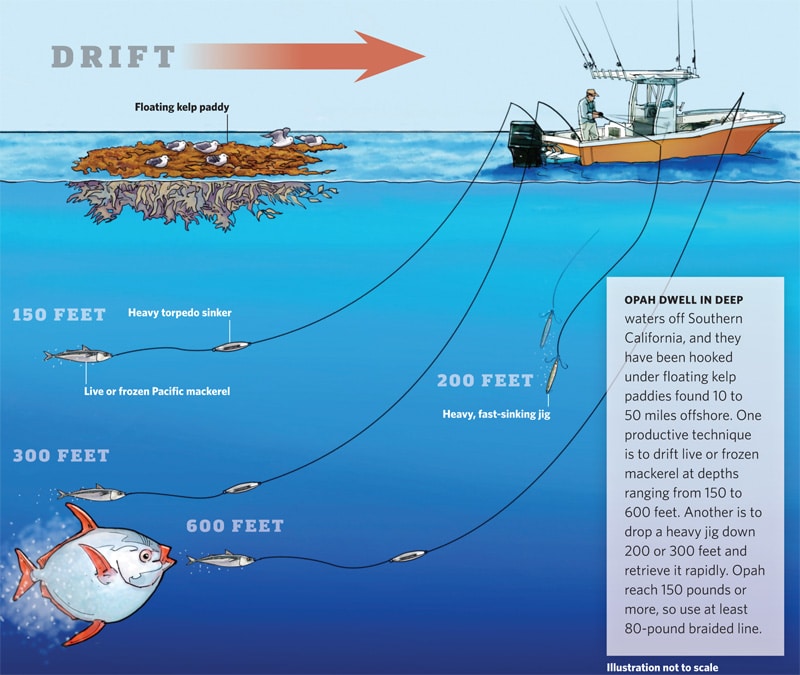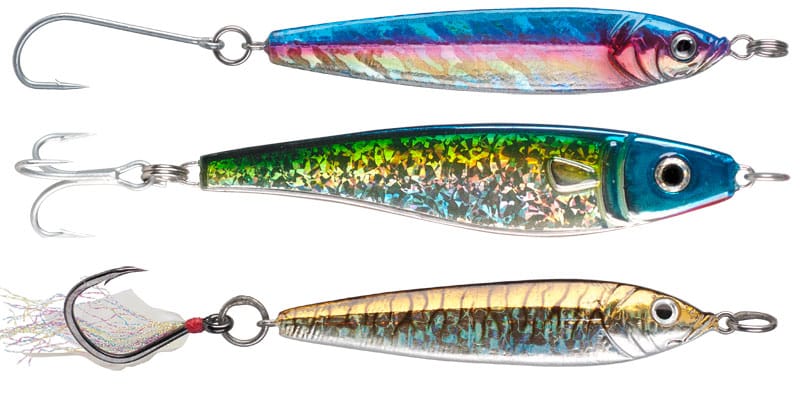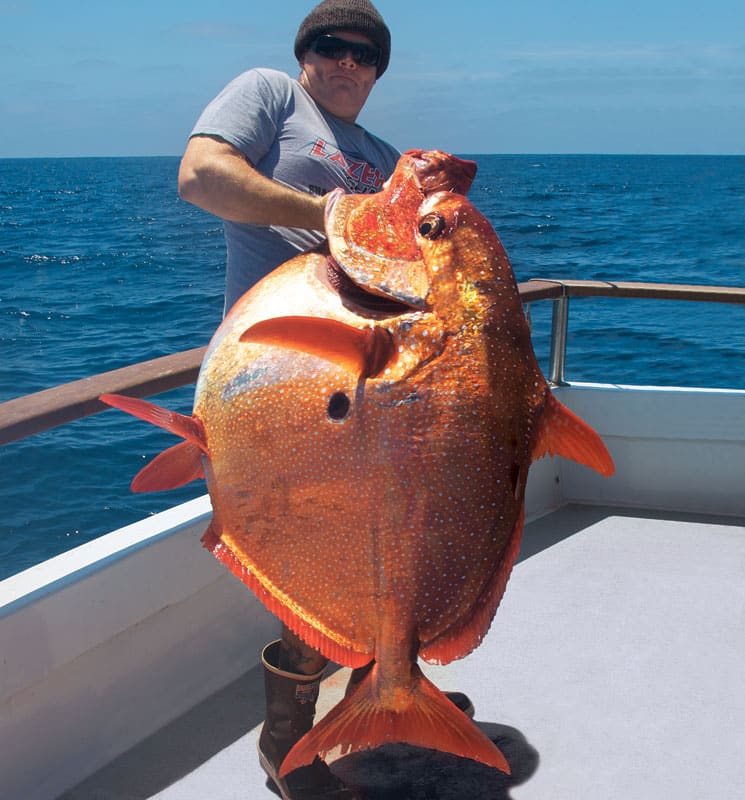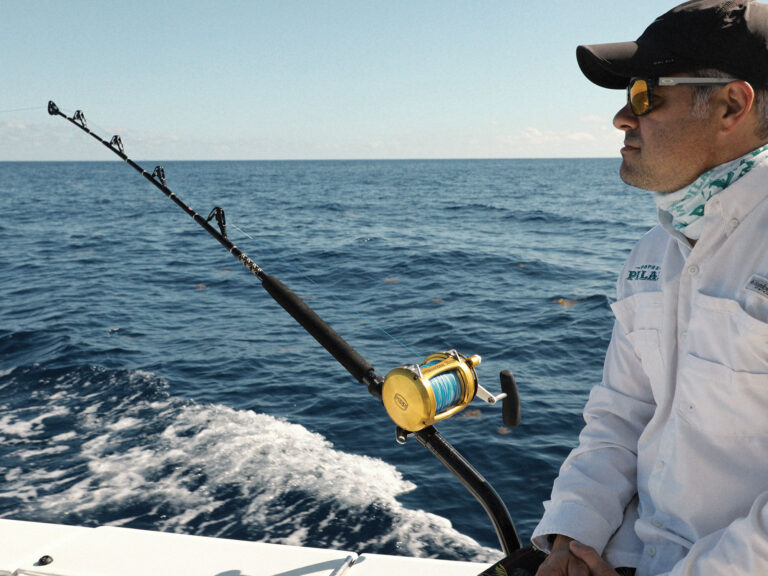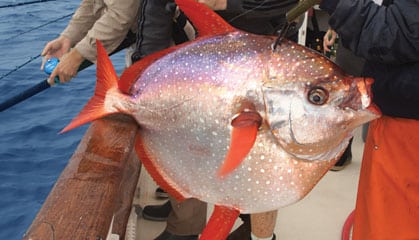
Kenny Fogarty had already had a good day of offshore fishing aboard his uncle’s 23-foot center console, Kaku, on an August afternoon in 2009 when he hooked what he thought was another bluefin tuna near a floating kelp paddy 30 miles off the coast of San Diego.
“I was fly-lining a live sardine when the fish bit and took off full speed, just like a tuna,” says Fogarty. The fish was strong, nearly emptying the Shimano Torium 14 reel of 30-pound-test braid on its first run. Fogarty worked to regain the line only to have the fish rocket away on another spool-depleting run. It eventually turned, but repeated the pattern a third and then a fourth time. An exhausting hour and 45 minutes later, the fish finally came to color, and Fogarty could scarcely believe his eyes.
It was an opah. Moments later, Fogarty’s uncle gaffed the fish. Later that day, it hit the scales at 88.8 pounds.
Rare Catch
Opah rank as one of the rarest catches off Southern California, but marine biologists and some anglers think these lone hunters are far more prevalent than catch rates might indicate. And while many consider them primarily a deepwater pelagic species, anglers like Fogarty have hooked them close to surface, while others have caught opah close to shore.
This past May, for example, Chas Leeper hooked and landed a 140-pound opah relatively close to shore while fishing off Newport Beach. Leeper and his cousin Skeeter Leeper and friend Ryan Swanson were trolling for thresher sharks just before dark in about 1,000 feet of water about three miles off the coast when the opah attacked a Williamson Bait ’O Matic with a Pacific mackerel pinned under the skirt.
Many of the opah caught offshore are hooked during twilight hours, so the time of Leeper’s catch is typical, but his hooking the fish so close to shore has many rethinking the behavioral patterns of opah. In fact, a year earlier, another big specimen was caught in the same area, leading some to conclude that opah are more wide-ranging and adaptable, as well as more plentiful, than previously thought.
“Opah are commonly caught by Hawaiian longliners targeting bigeye tuna,” says John Hyde, geneticist for the Southwest Fisheries office of the National Oceanic and Atmospheric Administration. “Our studies indicate that they might be nearly as abundant off the coast of California and northern Baja California.”
Feeding Habits
Opah are not fussy when it comes to food, according to scientific data and angler experiences. “They aren’t picky eaters,” says Hyde. “On our longlines, we simply just use large frozen mackerel.”
NOAA scientists have examined the stomach contents of captured opah and found them opportunistic predators. “Opah tend to eat a lot of midwater squids. But we have also found juvenile rockfish and sole in their stomachs,” Hyde says. The latter two species are bottom dwellers, indicating that opah hunt close to the ocean floor too.
Opah will also strike artificials. In fact, many caught from sport boats have been hooked on heavy jigs fished from 200 to 300 deep, says Bill Roecker, media representative for a number of San Diego boats. “At least half of the opah caught offshore are hooked on heavy jigs fished deep,” he says. “And most of the fish are caught at dawn and at dusk.”
Both the depth and the timing make sense. Hyde notes that opah tend to dwell during the day in the deep scattering layer, a horizontal zone of squid, fish and other marine organisms at depths of 600 to 1,200 feet. This layer — so named because it scatters sound waves and looks nearly like a bottom return on a fish finder — rises toward the surface in the evening and sinks again at dawn.
Yet this doesn’t explain Fogarty’s midday opah that bit near the surface or Leeper’s opah that struck near the beach.
Targeting Opah
Right now, opah is essentially a novelty game fish, albeit one that is highly prized. But the increasing catch rates indicate a sizable population, and there’s an angling strategy for opah developing in Southern California.
How do you increase your chances of catching one? If you regularly take summer or early fall offshore trips on passenger sport-fishing boats, your best bet is fishing deep with a heavy, fast-sinking metal jig, such as a Braid 6-ounce Slammer, MegaBait 41⁄2-ounce Kudako or Shimano JTVF 224 Butterfly.
“Basically, when we get into a tuna bite or on a kelp paddy, you want to get on the bow and drop a jig,” says Capt. Aaron Remy of the Searcher, based at Fisherman’s Landing, in San Diego Bay. “Let it sink a couple of hundred yards, jig it four or five times, then retrieve it quickly.
“The guys who have caught them have often inadvertently let the jig drop deep while they picked out a bird’s nest or an under-wrap,” he says. “Once they’re done, they bring the jig in quickly, and that’s when they get bit by an opah. But you’ll have to be patient and focused. It’s hard to bet on a long shot at hooking an opah, especially when we have tuna foaming off the transom.”
Another angling strategy for targeting opah is to imitate NOAA’s longline success by staggering baits at depths ranging from 150 feet down to 600 feet during the day. Since NOAA longline surveyors had success with large frozen mackerel, this would seem the most logical choice, though squid also makes sense, as it is a staple in the opah’s diet.
By combining persistence with techniques gleaned from longliners and the growing knowledge about opah off Southern California and Mexico’s Baja, you might add this jewel of the Pacific to your angling life list.
TRIP PLANNER
Capt. Aaron Remy’s party-boat tactics are proven producers, but private boaters too can score when dedicating summer and early autumn trips to targeting opah. As with any offshore fish, the key is to concentrate on life zones with indicators such as temperature breaks; schools of baitfish; diving birds; predators such as porpoise; and fish like dorado, marlin and tuna.
Rods: 7-foot medium-heavy-action conventional rods.
Reels: Medium-heavy reels such as Penn Torque TRQ30 or Shimano Torium TOR30.
Lines: 80-pound braid with 60-pound-test fluorocarbon top shot (opah have virtually no teeth).
Baits and rigs: Live or frozen Pacific mackerel; fast-sinking jigs like a MegaBait 41⁄2-ounce with a Kudako bucktail hook 1, MegaBait 61⁄2-ounce with a single hook 2 or Braid 6-ounce Slammer with a treble hook 3.
Terminal rigs: For baits, 6/0 to 8/0 J hook with 10- to 24-ounce in-line torpedo sinker.
What: Opah.
When: July through October.
Where: Banks and seamounts off the coast of Southern California and Mexico’s northern Baja California, including the 17, Osborn Bank, Avalon Bank, 14 Mile Bank, 209, 181, 182, 9 Mile Bank, 43, 302, 390, 1010 Trench and Double 220.
Who: Sport-fishing passenger boats targeting tuna, yellowtail and dorado offshore, as well as anglers with reliable craft from 23 feet. Here are sport-fishing passenger boats that regularly target offshore fish out of San Diego.
Capt. Aaron Remy
Searcher
619-226-2403
www.searchersportfishing.com
Capt. Bill Cavanaugh
Pacific Queen
619-221-8500
www.pacific-queen.com
**
Capt. Buzz Brizendine**
Prowler
619-523-8962
www.sportfisherprowler.com
